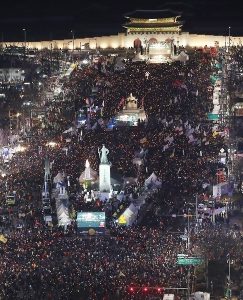April 26, 2022
SEOUL – On the evening of April 18, a four-way intersection in front of the Gangbuk-gu District Office in northwestern Seoul was filled with crowds and loud music, playing host to an outdoor concert.
Hundreds of people sang along as the night’s acts, including Dynamic Duo, played on the stage in a show organized by the district office to commemorate the 62nd anniversary of the April Revolution.
“The vibe was definitely different from before when people were not allowed to scream or chant at concerts,” said Lee, a Seoul resident who attended the event.

A screenshot shows the 4.19 Revolution National Cultural Festival, in which a crowd of people wave their smartphones and sing along to Korean hip-hop duo Dynamic Duo on the stage. (Courtesy of HNH TV)
It was the first day after Korea lifted a ban on fans chanting and singing at K-pop concerts.
Concertgoers were excited over the return of group singing and loud cheering, which had been banned since 2020 on fears of creating a superspreader event of the deadly virus.
Song, who has booked a ticket to the 2022 Beautiful Mint Life music festival to be held in May in Seoul, has high expectations for the upcoming show after experiencing a concert with a silent audience last year.
“Without sing-alongs, (the concert) wasn’t as fun as I thought it would be. I’m so looking forward to this year’s show,” said the college student.
A BTS fan also expressed excitement. The fandom, collectively called Army, is widely known for its unrivaled level of organization, but they were asked to stay silent and use “clappers” instead to show their support during the K-pop act‘s concerts in Seoul last month.
“It feels like I’m getting closer to my favorite artists when I sing along with them at concerts. Now that the ban is gone, many fan club members would be practicing group singing during the chorus,” said Park, who introduced herself as a 25-year-old college student living in Suwon, Gyeonggi Province.
Fan communities for K-pop artists often have their own rules for fan participation at concerts, like when to start singing along and when to taper off, as well as when to do the chants.
Singing culture
Korean music fans are known for their skill in singing along.
In a 2019 concert in Incheon, British singer-songwriter Anne Marie was moved to tears when the audience started jointly singing to her songs.
In a 2015 radio interview with Canada’s national public broadcaster CBC, Noel Gallagher, formerly of legendary British rock band Oasis, shared his own experience, saying Koreans “were singing all of it (‘Live Forever’), word for word, for their own amusement. … They got such a fun-loving spirit and they express themselves.”
Although sing-alongs are neither a new performance culture nor unique to Korea, why are Korean fans so enthusiastic about it?
Generally speaking, Koreans love to sing. And they don’t just love to sing in the shower. They love to sing together with friends, colleagues or strangers they meet at a street rally.
But when it comes to the massive sing-along culture at concerts, some experts have their own theories.
Culture critic Jeong Deok-hyun says it may be rooted in the nation’s traditional performing arts, in which audience participation played an essential part.
“In Korean madang geuk (traditional outdoor plays) or masked dances, it is common for actors to talk to the spectators to engage the audience. Words exchanged between performers and the audience become part of their show,” Jeong pointed out.

A screenshot shows a Korean traditional play based on the old tale ”Ong-Go-Jip Cheon,“ written anonymously during the Joseon era. It aired on KBS on Feb. 6, 1989. (KBS)

A screenshot shows an actor talking to an audience member during a play. (KBS)
Pansori, a traditional narrative musical genre, is another example.
In a pansori performance, a singer recites a long narrative to the rhythm of a drum, while combining it with singing. The audience responses to the singer’s passionate and sometimes mournful signing, with exclamatory words called “chuimsae,” like “Eolsigu” or “Jalhanda,” which roughly mean “yippee” and “great,” he added.
“From centuries-old interactive theatrical culture, Koreans share a notion that the audience is part of the show.”
Political critic Lee Jong-hoo pointed out that crowd singing is also a big part of the protest culture here.
“Just like the ordinary people of the Joseon era, for whom singing and dancing together were a means to express anger and disappointment toward corrupt officials, modern Koreans have been singing protest songs together to bring out unity and elevate their fighting spirit during times of social and political unrest,” he said.
There are such historically important protest songs like “March for the Beloved,” the anthem of the May 18 Gwangju Democratic Uprising, and “Morning Dew” from the June 1987 Democratic Struggle.
The tradition has continued to this day, seen recently at the candlelight vigils in 2016 and early 2017 against the eventually impeached President Park Geun-hye.

Protesters hold a rally on Feb. 11, 2017, in central Seoul in their 15th weekly candlelight vigil, calling on impeached President Park Geun-hye to resign. (Yonhap)
“By singing along and dancing, Koreans have tried to build solidarity within their community. Also, they have a craving for collective joy. Doing something ‘together’ both in times of crisis and peace means a lot to Koreans,” Lee said.


